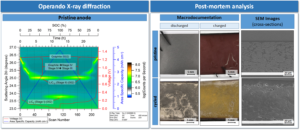Summary:
Concerning cell ageing and lithium-plating, electrode kinetics – in particular the one of the anode – plays an important role. During cyclic ageing both electrodes are subject to microstructural and chemical changes that might have a negative influence on the electrode kinetics, such as layer formation, transition metal dissolution and subsequent deposition and pore clogging. These ageing induced changes potentially reduce the capacity of the electrodes at a given current rate, moreover, they are also able to trigger further ageing processes such as Li-plating. Despite its importance, the influence of these aging induced chemical and microstructural changes on the intercalation kinetics is not fully understood so far.
In our study, we present a post-mortem analysis of cycled laboratory scale pouch cells with NCM622 cathode and a graphite-based anode. We applied physicochemical post-mortem analysis to get insights into the microstructural and chemical changes of the electrodes. Rebuilt half cells reveal the contribution of the individual electrodes to the overall capacity fade of the cell. To understand the effect of microstructural changes on electrode intercalation kinetics, and as a key aspect of the study, operando X-ray diffraction measurements were applied.
The key findings are as follows: Li-plating and loss of cycable lithium is the main source of capacity fade of the cell. Cycling causes anode pore clogging leading to an increased transport resistances for Li-ions. This causes that the intercalation is not homogeneous over the thickness of the electrode resulting in a Li-gradient. LiC6 forms in surface-near regions, whereas in deeper regions LiC12 formation has not finished. As a result, Li-plating is triggered as the surface near graphite is already fully intercalated and Li-ion transport to deeper regions is hindered due to pore clogging.
We are happy to forward your request / feedback.

